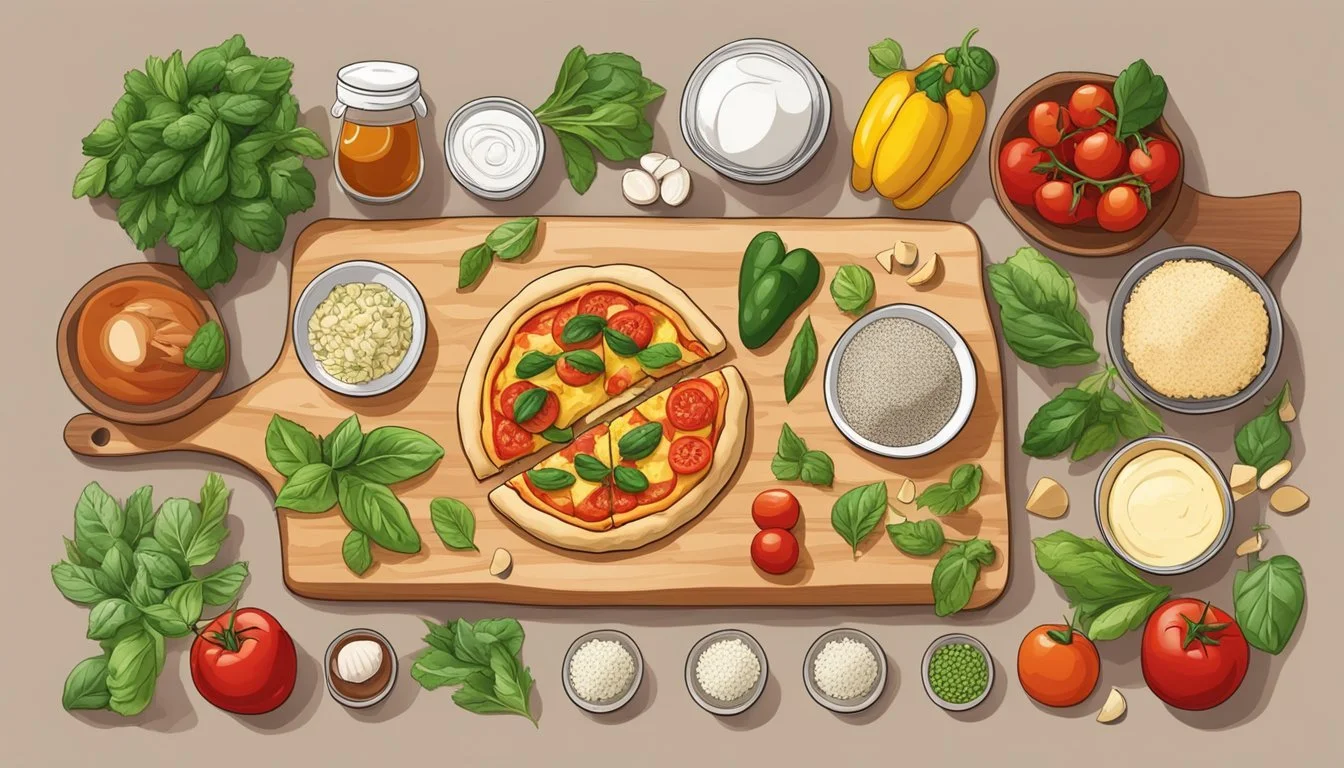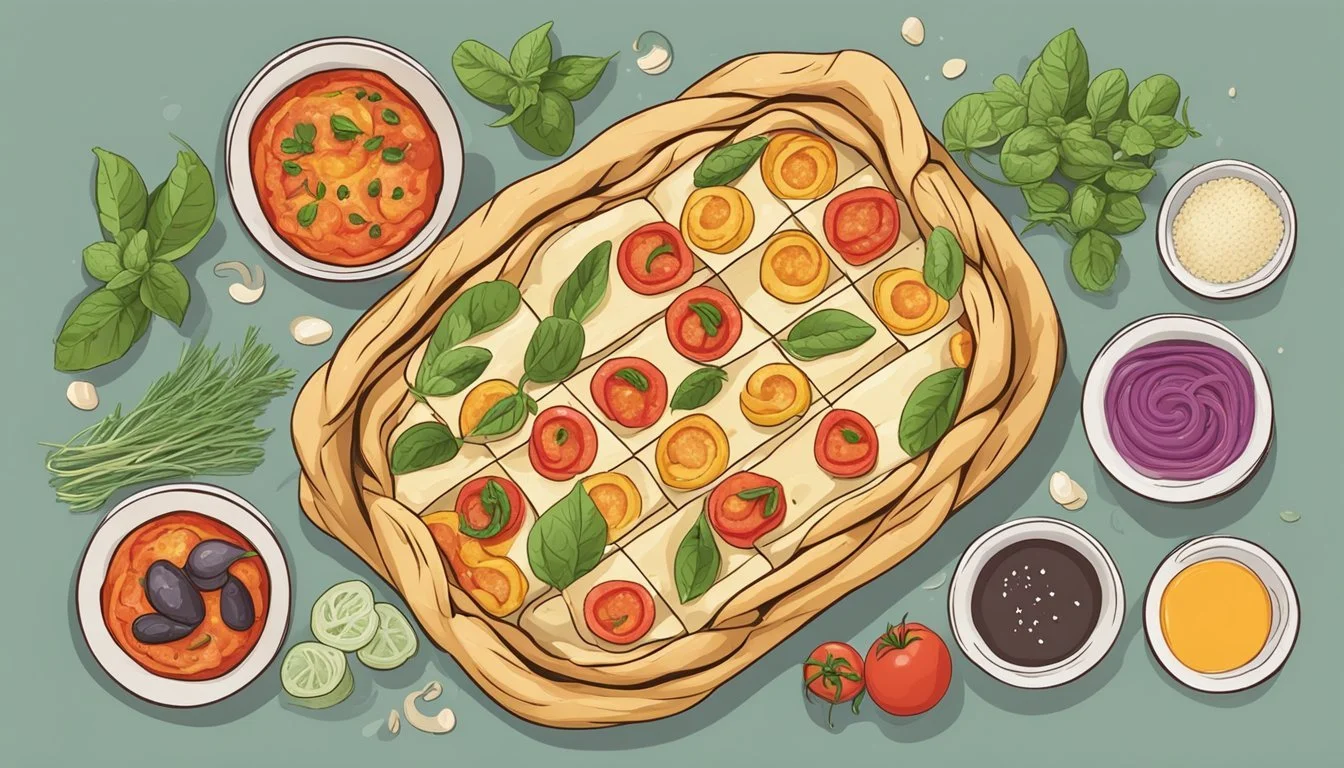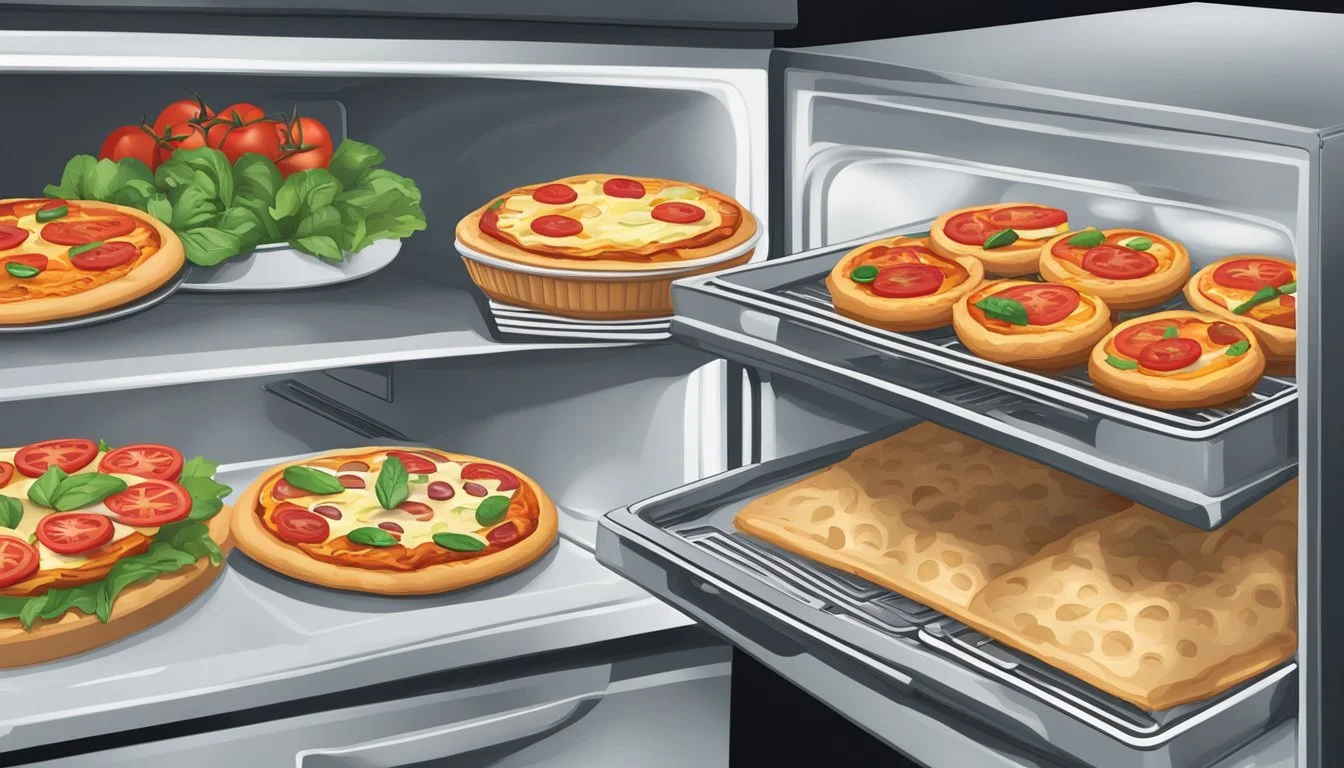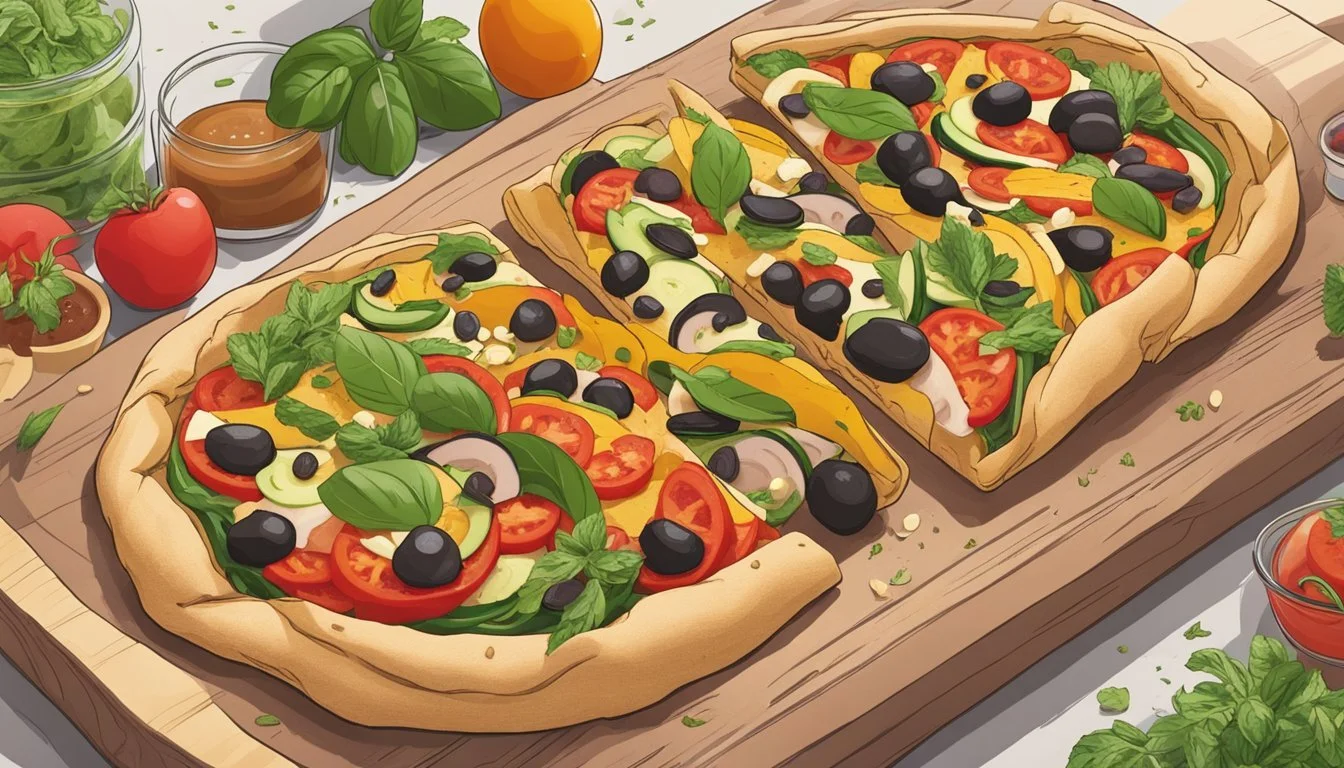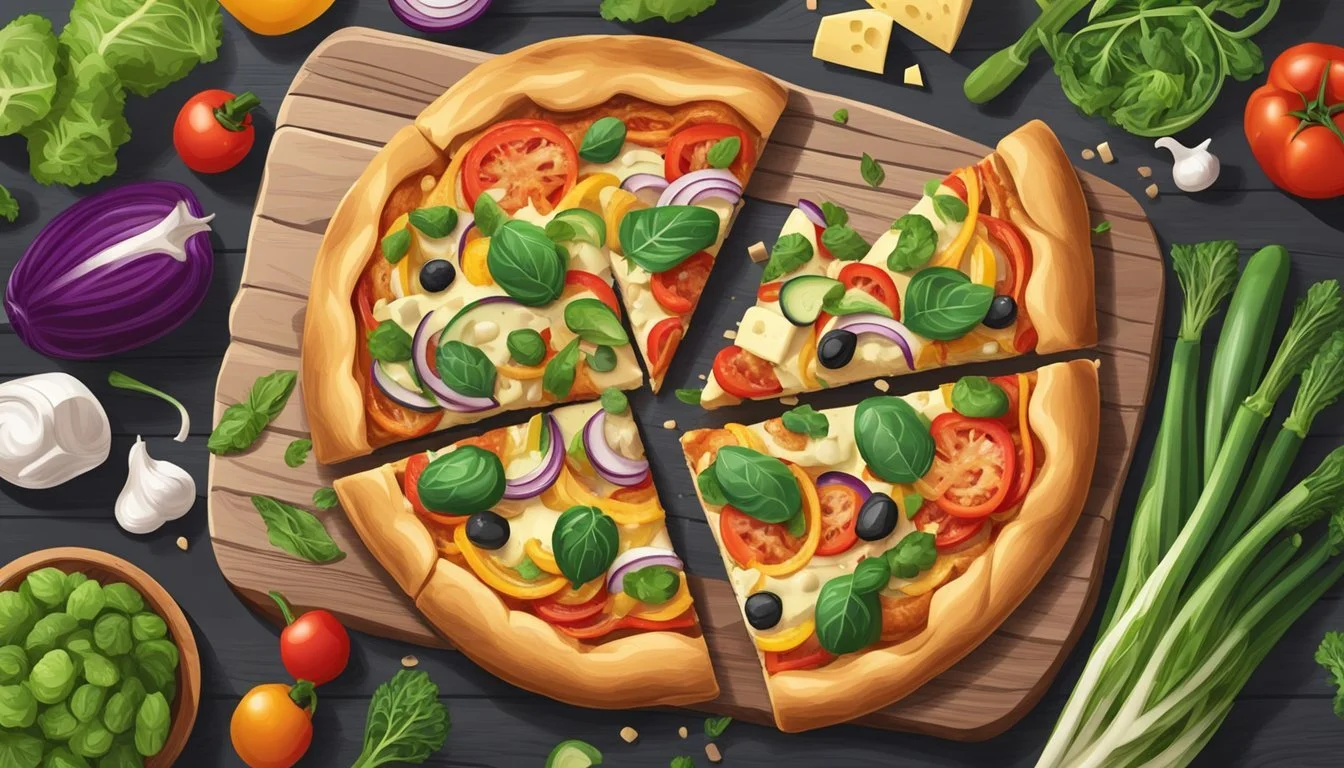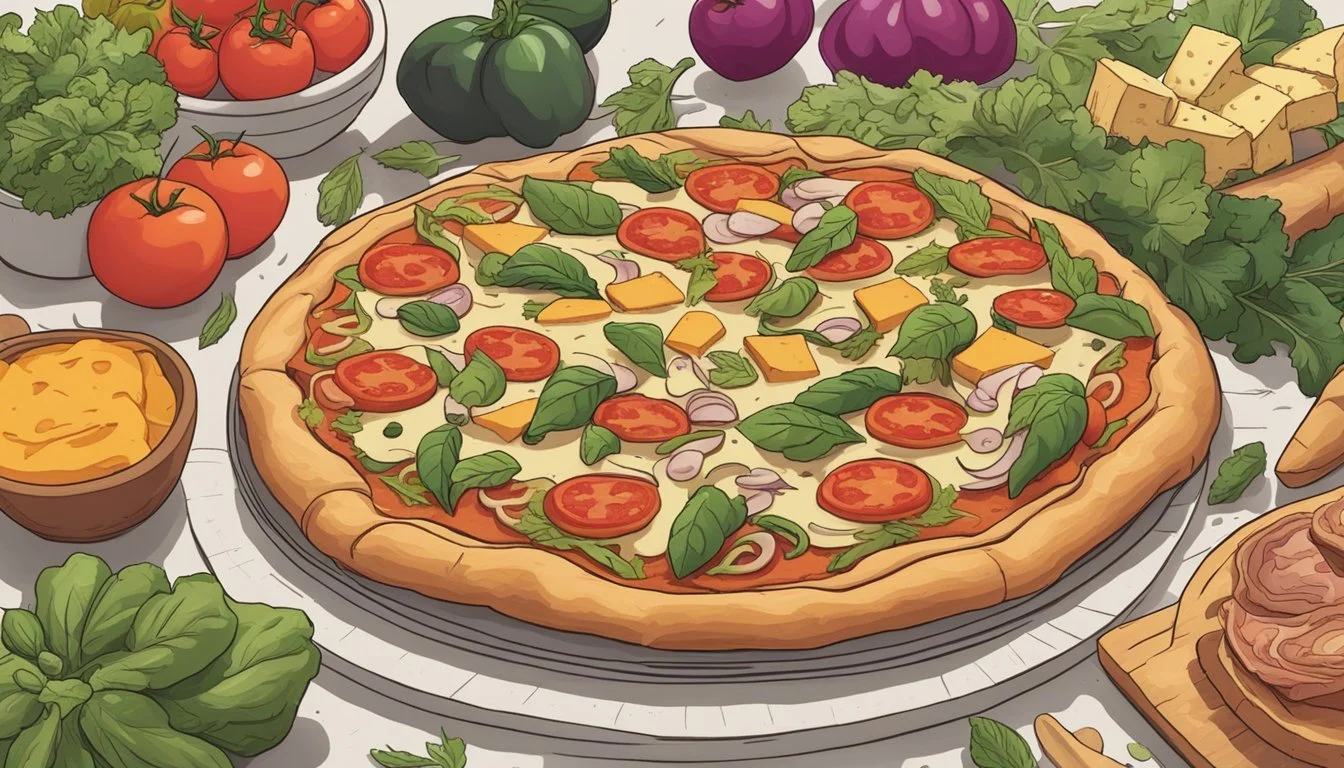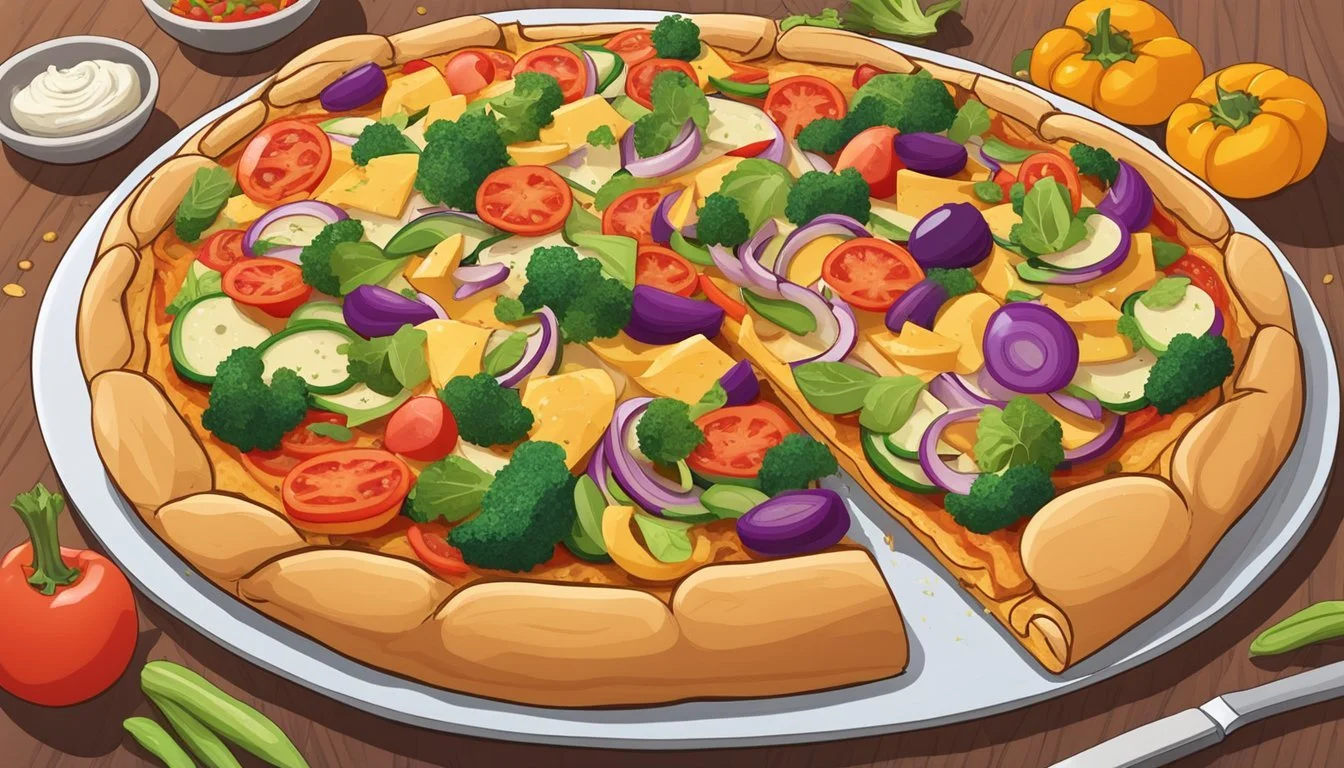Is Pizza Braid Vegan?
Uncovering Ingredients and Options
A pizza (What wine goes well with pizza?) braid combines the flavors and textures of traditional pizza with a fun, plaited presentation. It typically involves laying out pizza dough, adding toppings like sauce and cheese, and then folding the dough strips over the filling to create a braid-like effect. When considering whether a pizza braid is vegan, one must examine the ingredients used in each component of the dish.
The versatility of pizza allows for a multitude of dietary adaptations, including vegan variations. Pizza dough, at its most basic with flour, water, yeast, and salt, is inherently vegan. However, veganism extends to all layers of the dish; this means that for a pizza braid to be vegan, the sauce, cheese, and any additional toppings must also be plant-based. Pre-made vegan cheeses and a variety of vegetable toppings can be used to achieve a fully vegan pizza braid.
While traditional pizza braids are laden with meats and cheese, the rise of plant-based diets has inspired adaptations to this comfort food classic. Vegan Outreach details how a vegan pizza braid can be created using vegan shredded cheese and vegetable toppings. Ensuring the absence of animal products in the dough and substituting with ingredients like vegan cheese confirms that pizza braid can indeed be enjoyed in a vegan diet.
What is a Pizza Braid?
A pizza braid combines the hearty toppings of a pizza with an intricately woven dough structure. This culinary creation is baked until the crust reaches a golden hue, providing both a visual and gastronomic twist to traditional pizza.
Defining the Braid
The pizza braid is characterized by its braided dough, which envelops the chosen toppings in a pattern resembling a plait. Dough is rolled out into a rectangle, and then strategic cuts are made along both edges, leaving a strip down the center for toppings. Once ingredients like cheese, sauce, and other toppings are layered on, the dough strips are alternately folded over to create the braid. Properly executed, the braid not only secures the toppings inside but also enhances the pizza's aesthetic with its woven look.
History of Pizza Braids
Pizza braids are a relatively modern take on traditional pizza and bread baking. They stem from the age-old practice of braiding bread, a technique adopted by many cultures for centuries to create visually appealing loaves. Merging this technique with the universally beloved pizza, bakers began to form pizza braids, offering a fresh spin on classic flavors. The history of the pizza braid neither defines a particular culture nor a specific period but rather illustrates culinary innovation — an adaptation that leverages familiar elements of pizza and braided bread to create something new and inviting.
Ingredients for Making Vegan Pizza Braid
When crafting a vegan pizza braid, it's crucial to select the right combination of ingredients that comply with vegan standards, such as dairy-free cheese and plant-based dough. Each component needs to contribute to the overall flavor, while maintaining the integrity of a vegan diet.
Choosing Suitable Flour
For the dough, one needs a high-quality flour—either all-purpose or bread flour is ideal for achieving the desired consistency. Gluten-free flours can also be used for those avoiding gluten. It should be mixed with water, a pinch of salt, and yeast—ensure that the chosen yeast doesn't contain any animal-derived ingredients like honey. If the recipe calls for a sweetener, opt for maple syrup instead.
Vegan Cheese Options
Vegan cheese is pivotal for the 'cheese pull' and flavor. Ingredients in vegan cheese should avoid whey and casein, animal-based proteins commonly found in dairy cheese. Vegan cheese can be based on soy, nuts, or root vegetables and often incorporates nutritional yeast for a cheesy zing. Options include mozzarella-style shreds, cheddar flavors, or homemade cashew cheese.
Tomato and Other Vegan Sauces
The best vegan sauces start with a tomato base, such as classic marinara or pizza sauce, which should be confirmed to have no hidden animal products like cheese or honey. For a diverse flavor profile, one can also use pesto or white garlic sauces, making sure they're devoid of non-vegan ingredients like parmesan cheese.
Herbs and Spices for Flavoring
Herbs and spices are where one can truly customize the flavor. A combination of dried oregano, basil, and perhaps a bit of red pepper flakes can add depth. One may also consider fresh herbs applied after baking to maintain their vibrant taste.
Vegetable Toppings
Finally, the vegetable toppings add both nutrition and taste. Consider a variety of colors and textures with onions, bell peppers (What wine goes well with bell peppers?), mushrooms, and even pineapple for a hint of sweetness. Ensure that all vegetables are cut uniformly for even cooking and optimal presentation.
Preparing the Vegan Dough
The preparation of vegan pizza dough is a critical step in crafting a delectable pizza braid. It involves precise mixing of ingredients, a necessary rise time for dough development, and shaping the dough to fit the braiding process.
Mixing and Kneading the Dough
One begins by activating the yeast in warm water with a pinch of sugar, watching for a foamy layer to ensure its readiness. To the activated yeast, one then adds the flour — a combination of all-purpose and whole wheat for robust flavor — along with salt and a touch of olive oil for elasticity. The amalgamation of these ingredients is best done with a fork initially, progressing to hand-kneading or using a mixer with a dough hook to achieve a smooth and elastic consistency.
Letting the Dough Rise
After kneading, the dough must be transferred to a greased bowl, covered, and allowed to rise in a warm, draft-free environment. It is essential that the dough doubles in size, an indicator of proper yeast activity and gluten development. This process typically takes about an hour but can vary depending on the ambient temperature.
Rolling the Dough into a Rectangle
Once risen, the dough is ready to be shaped. On a lightly floured surface, the dough is rolled out to a rectangular shape — a critical form for braiding. The dimensions of the rectangle are not set in stone, but it should be sufficiently large to allow for the subsequent addition of toppings and the braiding technique one desires to employ. Rolling should be even to avoid thin spots that could tear during assembly.
Assembling the Pizza Braid
In crafting a pizza braid, a key consideration is the arrangement of ingredients and the execution of a braiding technique that secures the toppings within the dough.
Arranging Toppings on the Dough
First, the dough should be shaped into a rectangle on a prepared baking sheet. For vegan pizza braids, one must consider using vegan dough, free from any animal products. The chef spreads the sauce evenly, leaving a border to ensure the filling remains contained. A combination of vegetables, vegan cheese, and if desired, vegan protein substitutes—like plant-based sausage—can be used as toppings. These ingredients are then arranged down the center third of the dough, a critical spatial consideration to achieve the braid. Garlic powder and pepper may be added for extra flavor.
Example Toppings Layout:
Sauce: A thin layer down the center.
Vegan Cheese: Sprinkled liberally along the sauced area.
Pizza Toppings: (What wine goes well with pizza toppings?) Diced peppers, olives, (What wine goes well with olives?) etc., kept within the confines of the center third.
Seasoning: A pinch of garlic powder and ground pepper to taste.
Braiding Technique
Once the toppings are in place, it’s time to create the braid. With a knife, the chef cuts diagonal strips along both long edges of the dough, ensuring each strip is approximately equal in width. They leave an uncut section in the middle where the toppings are placed. The braid is formed by alternately folding strips from each side over the toppings, slightly overlapping to achieve a firm hold. The braid's surface can be brushed with a small amount of olive oil for a crispy finish upon baking. This technique not only encases the toppings but also results in a visually pleasing braided effect after baking.
Braiding Steps:
Cut Strips: Diagonal strips on either side of the toppings.
Begin Braiding: Alternating strips folded over toppings.
Seal Ends: Ensure the dough is pinched at the ends to prevent spillage.
Olive Oil Brush: Lightly coat for a golden crust.
It's important to secure the braid properly to prevent the filling from leaking during baking, which would disrupt the intricate form of the braid and potentially the distribution of flavors.
Baking Vegan Pizza Braid
Crafting a vegan pizza braid involves precise oven preparation, adhering to baking times for that golden perfection, and setting up your baking sheet correctly to handle the dough without sticking.
Preheat and Prepare the Oven
The initial step requires the baker to preheat the oven. For a vegan pizza braid, one would typically set the oven to a temperature ranging between 350°F to 375°F (175°C to 190°C). It is essential to allow the oven to reach the desired temperature before the braid enters the oven to ensure even cooking and a crisp exterior.
Bake to Golden Perfection
Baking time is crucial; a vegan pizza braid generally needs to bake for 20 to 25 minutes. The baker should look for visual cues—the braid should turn golden brown on top. For accurate results, one should consider using an oven thermometer to confirm the oven reaches the correct temperature.
Baking Sheet Setup
Before the pizza braid can be baked, one must prepare the baking sheet. It involves lining the sheet with parchment paper to prevent sticking and allow for easy removal of the pizza braid once baked. The dough should be well-spaced on the baking sheet to provide even heat distribution and room for the braid to expand as it bakes.
Serving and Pairings
When serving a pizza braid, one must consider complementing tastes and textures that enhance the overall dining experience, whether it's for lunch or dinner. Vegan pizza braid, as the main attraction, pairs beautifully with various side dishes and can be presented in an aesthetically pleasing manner to excite the palate.
Recommended Side Dishes
Garlic Toast: A crunchy garlic toast can accompany the pizza braid, adding a different texture and garlicky flavor.
Salad: A fresh salad with a light vinaigrette can balance the richness of the vegan cheese and bread.
Appetizers: Small vegetable-based appetizers like bruschetta offer a refreshing contrast before the main course.
Serving Suggestions and Presentation
Sauces: Serve the braid with a side of marinara sauce for dipping, adding an extra layer of flavor.
Lunch Portions: Cut the braid into smaller portions for a satisfying and easy-to-handle lunch option.
Dinner Presentation: When serving for dinner, slice the braid into larger segments and present it on a wooden board for sharing.
Storing and Reheating Leftovers
When it comes to leftover pizza braid, proper storage and reheating techniques can make a significant difference in preserving taste and texture. A pizza braid, given its stuffed nature, can become soggy if not stored correctly, and its plant-based ingredients can lose their appeal if reheated poorly.
Best Practices for Storage
Storage:
In the refrigerator: Wrap slices individually in aluminum foil or store them in an airtight container to prevent the braid from drying out.
Duration: Leftovers should be consumed within 3-4 days to maintain the quality while ensuring safety.
How to Reheat for Best Results
Reheating:
In the oven:
Preheat the oven to 375°F (190°C).
Place the pizza braid on a baking sheet or directly on the oven rack for crispiness.
Heat it for 10 to 15 minutes, checking regularly to avoid burning.
On the stovetop (Skillet method):
Place the pizza braid in a dry skillet on low heat.
Cover with a lid to trap steam and heat evenly.
Reverse the slices halfway through heating for an even warm-up.
By adhering to these storage and reheating practices, one can retain much of the original flavor and texture of the pizza braid while also being mindful of calorie content, as reheating methods do not significantly alter the calorie count of the food.
Customizing Your Vegan Pizza Braid
Creating a vegan pizza braid offers a delightful twist to traditional pizza by combining the joy of a flaky, braided crust with the endless possibilities of vegan toppings. This section will guide the reader through ways to personalize their vegan pizza braid and generate ideas for a memorable build-your-own pizza night.
Adding Personal Touches to the Recipe
A vegan pizza braid is an excellent way to showcase one's creativity in the kitchen. Here are some specific options for customization:
Sauces: Beyond classic tomato sauce, experiment with pesto, barbecue, or even a creamy garlic sauce as a base layer in the braid.
Cheeses: Use a variety of vegan cheeses. Meltable mozzarella-style, tangy feta-style, or homemade cashew cheese can add depth to the flavor profile.
Veggies: Incorporate color and nutrition with an array of vegetables. Black olives, green bell pepper, red bell pepper, and jalapeños can be sliced and layered for both heat and crunch.
Proteins: Tempeh (What wine goes well with tempeh?), tofu, or store-bought vegan meats diced into bite-sized pieces are great for added substance.
Build Your Own Pizza Night Ideas
Host a build-your-own pizza night to make mealtime interactive and enjoyable. One can set out bowls of prepared ingredients, and guests can choose their favorites to add to their braid. Here's how to organize the toppings:
Category Ingredients Sauces Tomato, BBQ, Pesto, Garlic Aioli Vegan Cheeses Mozzarella-style, Feta-style, Cashew cheese Vegetables Black Olives, Green Bell Peppers, Red Bell Peppers, Jalapeños Proteins Diced Tempeh, Tofu, Vegan Sausage
Ensure all toppings are chopped uniformly to cook evenly and offer an array of colors and textures for visual appeal and varied taste. The key is to balance flavors so that each bite delivers a satisfying taste of the custom-tailored vegan pizza braid.
Vegan Pizza Braid as a Meal Option
A vegan pizza braid is a creative and satisfying meal choice, especially for those adhering to a plant-based diet. It uses vegan-friendly ingredients and can be tailored to include a variety of nutrient-rich toppings.
Benefits for Dinner Parties
Vegan pizza braids present a visually appealing and inclusive option that is sure to impress guests. By incorporating vegan mozzarella and a selection of vegetables, hosts can cater to diverse dietary requirements without compromising on taste or presentation. Additionally, the braided format of the pizza lends itself to easy sharing, making it a perfect centerpiece for social gatherings.
Vegan-Friendly: A recipe can easily adapt to include only plant-based ingredients.
Customizable: Various toppings such as olives, peppers, and plant-based meats can be added.
Nutritional Advantages
The nutritional profile of a vegan pizza braid can be quite beneficial. Replacing traditional cheese with vegan mozzarella or sprinkling nutritional yeast offers a dose of protein without the cholesterol found in dairy products. A thoughtfully composed vegan pizza braid can also provide significant vitamins and minerals from the vegetable toppings while keeping calories in check.
Calories: Controlled by portion size and choice of toppings.
Ingredients: Can include a mix of fresh vegetables and vegan proteins.
By selecting a whole-grain dough and incorporating ingredients like spinach and mushrooms, one can enhance the fiber and antioxidant content of the meal. This not only contributes to a well-balanced diet but also ensures that those enjoying the pizza braid are receiving a variety of nutrients essential for good health.
Substitutes and Alternatives
Crafting a vegan pizza braid can be a delightful experience, given the array of substitutes available for traditional ingredients. Ensuring a delectable outcome entails carefully selecting non-dairy cheese varieties, gluten-free options for those with allergies, and versatile sauce choices.
Gluten-Free and Allergy Considerations
For individuals with gluten sensitivities or allergies, gluten-free flour blends are a suitable substitute for conventional wheat flour. A pizza braid can be made using a blend of rice, potato, and tapioca flours, which mimic the texture and binding qualities of gluten. It's crucial to note that recipes may require a binder, such as xanthan gum, to compensate for the lack of gluten.
Non-Dairy Cheese Varieties
Mozzarella-Style: Often made from a base of coconut oil and starches; melts well.
Cheddar-Style: Cashew or soy-based; adds a sharp taste similar to dairy cheddar.
Gourmet Blends: Artisanal vegan cheeses from nuts or seeds; great for distinctive flavors.
Choosing the right vegan cheese for a pizza braid is essential for both taste and meltability. Vegan cheese varieties have come a long way, with products made from nuts like cashews or soy. These cheeses aim to capture the creaminess and flavor of traditional dairy cheese and are available in styles that replicate mozzarella, cheddar, and other gourmet blends.
Alternative Sauce Selections
Classic Marinara: A simple blend of tomatoes, garlic, herbs, and olive oil; inherently vegan.
Spicy Tomato Sauce: Infused with chili flakes or fresh peppers for those who prefer some heat.
Creamy Almond-Based White Sauce: An alternative for a non-tomato base; enriched with nutritional yeast for a cheesy flavor.
The base sauce for a pizza braid is pivotal to its overall flavor profile. Traditional marinara sauce, made from tomatoes, onions, garlic, and herbs, is vegan-friendly. However, for those seeking variety, there are options such as a spicy tomato sauce for a kick or a creamy almond-based white sauce for a richer, cheese-like foundation. These alternatives can be easily adjusted to personal taste preferences and dietary needs.
Troubleshooting Common Vegan Pizza Braid Issues
Crafting a vegan pizza braid can come with its own set of challenges, from achieving the perfect crust texture to ensuring rich, savory flavors throughout. This section will address common difficulties and offer direct solutions for overcoming them.
Possible Baking Challenges
Consistency of the Crust: A frequent issue pertains to achieving a golden and crisp crust. If the crust appears underbaked, one should verify that the oven is properly preheated and is at the correct temperature—typically around 375°F to 425°F. A reliable oven thermometer can prevent inaccuracies in temperature settings. Moreover, adjusting the bake time may be necessary; while a standard prep time might be 20 minutes, the total bake time can extend beyond initial expectations.
Uneven Browning: Rotate the pizza braid midway through the cooking time to ensure even browning. Placing the braid on a higher oven rack can also promote a more uniform golden color.
Yeast Activation: If the crust lacks rise, it's crucial to confirm that the yeast was active when mixed with warm water. Yeast should be stored in a cool, dry place and checked for expiration to maintain its efficacy.
Texture and Flavor Adjustments
Crust Texture: For a fluffier crust that mirrors traditional pizza braids, one can focus on the kneading process. Kneading for at least 5-6 minutes encourages gluten development, which enhances the structure and chewiness of the crust. It is also imperative not to add excess flour during this phase as it might lead to a denser result.
Flavor Enhancement: An underwhelming flavor can be addressed by incorporating herbs such as Italian seasoning into the dough. Additionally, a thorough blend of flavorful toppings—like aromatic garlic, zesty olives, or rich plant-based toppings such as vegan pepperoni—can elevate the taste profile significantly.
In conclusion, while these adjustments can significantly improve the outcome of a vegan pizza braid, it is essential to consider the specifics of one's recipe and personal taste preferences when troubleshooting.
Conclusion
A pizza braid, an inventive twist on traditional pizza, is essentially a plaited bread stuffed with pizza toppings. For a pizza braid to be vegan, the ingredients need to exclude dairy, eggs, and any non-plant-based additives. The dough—commonly a blend of flour, yeast, water, and salt—is inherently vegan. Vegans can enjoy a variety of recipes that adapt this Italian-inspired dish to their dietary needs.
When considering toppings, care must be taken to select vegan cheese and sauces, ensuring they are free of animal products. A traditional pizza braid filling may include pepperoni or sausage, but replacing these with plant-based alternatives ensures the entire meal remains vegan.
Preparation Time: With an efficient recipe, one should allocate approximately 20 minutes for assembly before baking. The overall time commitment is comparable to that of creating a classic pizza, with the braiding step adding a touch of artistry to the process.
In terms of serving, the vegan pizza braid presents a visually appealing option that doesn't compromise on taste. It can be cut into slices after baking, making it a convenient and sociable dish to share. As vegan diets continue to gain popularity, the adaptation of dishes such as the pizza braid showcases the versatility and innovation present in vegan cuisine.



